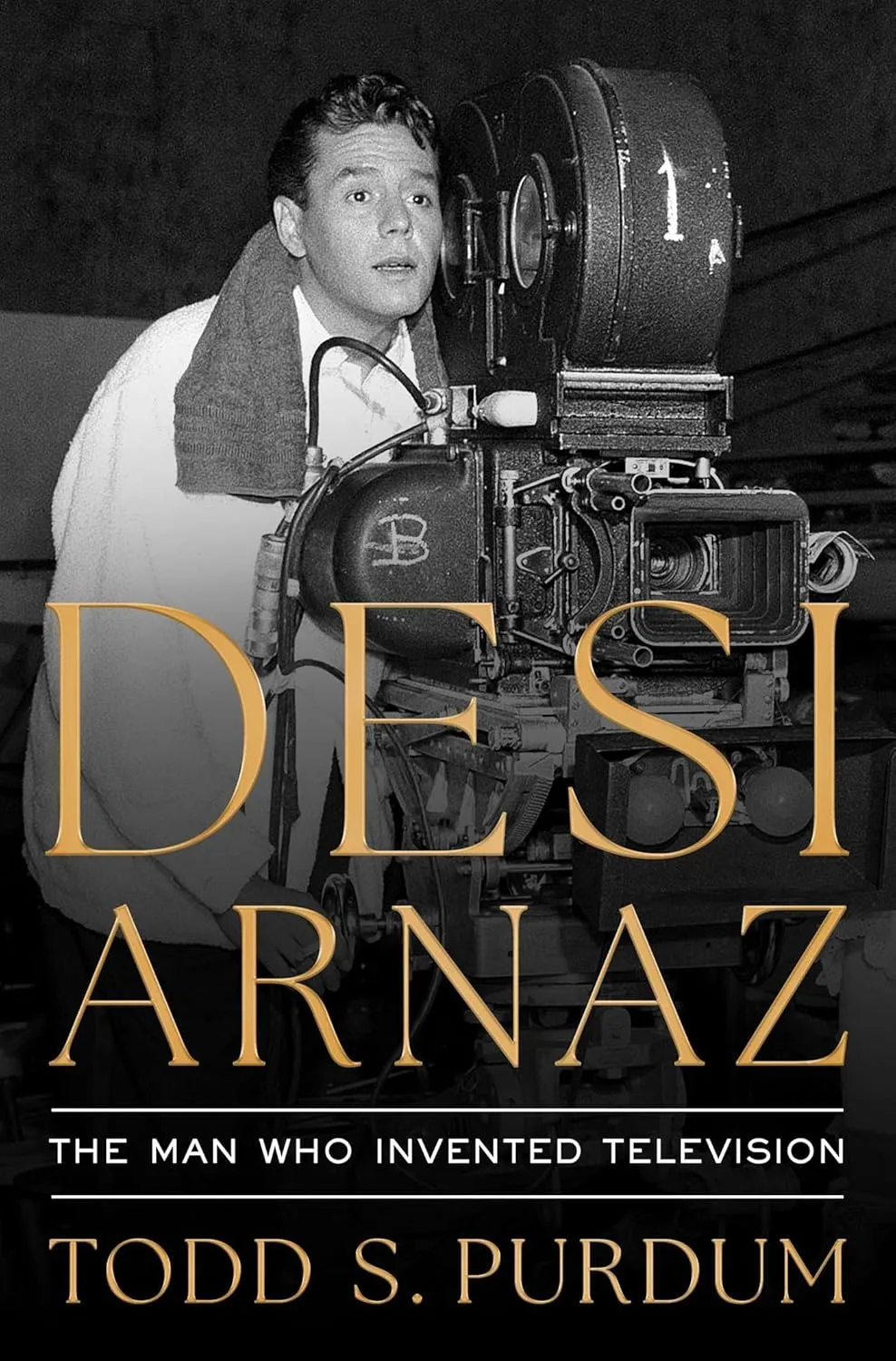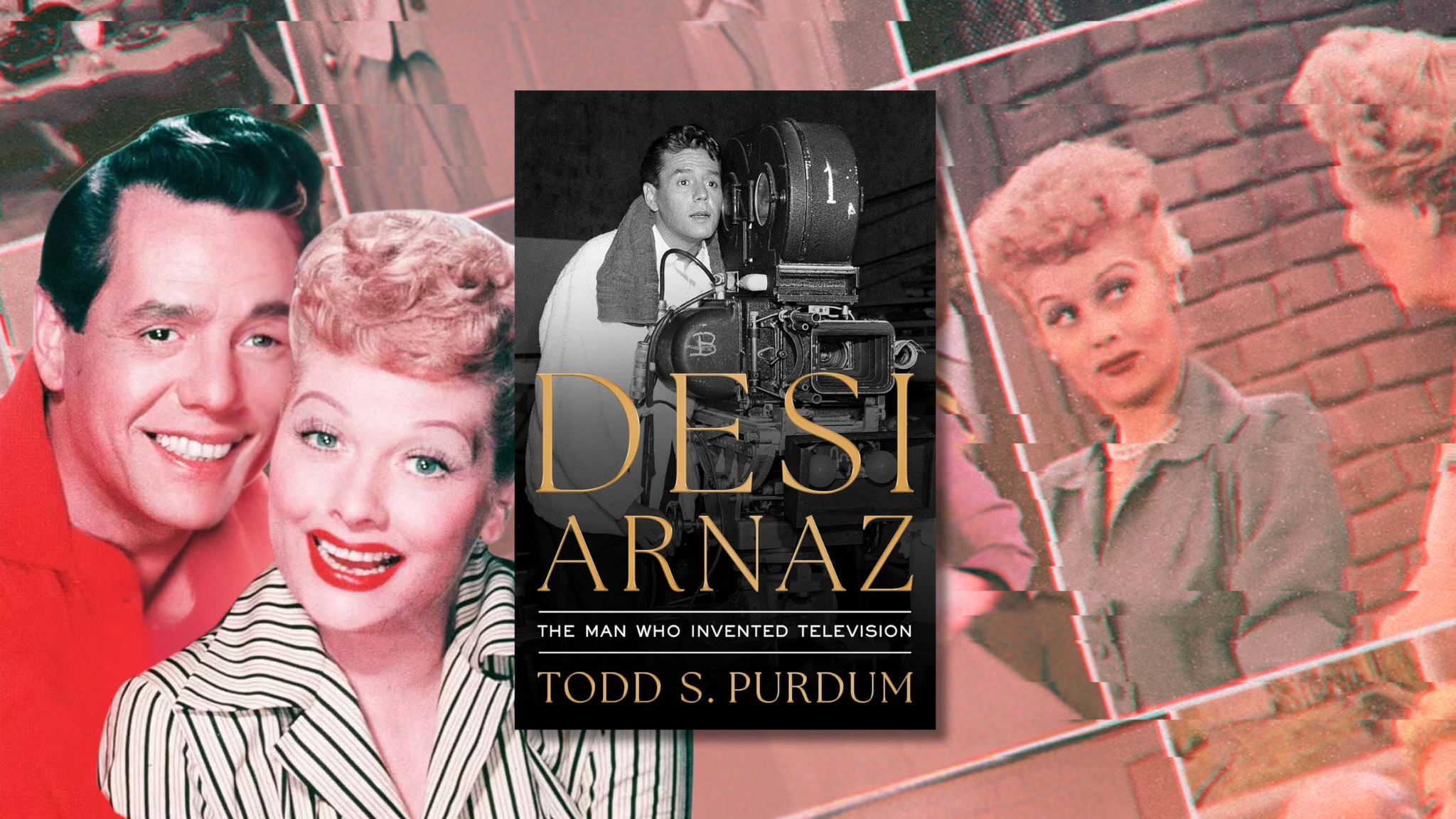Desi Arnaz: The Man Who Invented Television by Todd S. Purdum
Todd S. Purdum has written Desi Arnaz, subtitled The Man Who Invented Television, an enlightening and significant biography about the man who truly did love Lucy. It’s a timely reminder of the vast number of contributions to the entertainment industry this Cuban refugee turned proud American citizen made that may have been overlooked or forgotten since his death at the age of 69 in 1986. This insightful book could not have been written without the full cooperation and encouragement from Lucie Arnaz Luckinbill and her brother Desi Arnaz IV, who shared their memories, photographs and the vast archive of films, videos, documents, and memorabilia that Lucie maintains of her pioneering family.
From Cuban Aristocrat to Penniless Refugee
Desi Arnaz was a visionary, a sharp, quick-witted cultural revolutionary whose creative solutions devised to address the myriad problems presented by the nascent television industry quickly became incorporated as standard operating procedures. Impossible was a challenge and not part of his vocabulary. He collaborated with top experts, including Karl Freund, the exceptionally talented and inventive German cinematographer and director, and Jess “the Brains” Oppenheimer, head writer/ producer of I Love Lucy and other programs. Up until this time, New York-based programs were kinescoped by filming a studio monitor and then rebroadcast later to other time zones. After thorough rehearsals, I Love Lucy was filmed in Los Angeles with 3 cameras in front of live audiences whose natural laughter and reactions were recorded rather than the false and often annoying “laugh-track” commonly used. These methods paved the way for future income streams of syndicated reruns with superb picture quality. Before performances, Desi personally warmed up the viewers with anecdotes and occasional songs and sometimes introduced his children.
Desi Arnaz, born Desiderio Alberto Arnaz y de Acha III on March 2, 1917 in Santiago de Cuba, the second largest city and capital of this southeastern province of Cuba, was the only child of the city’s wealthy youngest mayor and member of the House of Representatives. His mother Dolores “Lolita” de Acha was famed for her beauty and later her difficult temperament. His grandfather Alberto de Acha was a co-founder and executive with Bacardi rum. The handsome boy, descended from Cuban nobility, was accustomed from birth to the privileged lifestyle of his family’s grand homes, numerous servants, fine automobiles, well-tailored clothing and private schools. The expectation was Desi would go to Notre Dame or an equally suitable, preferably Catholic university, to become a lawyer and future leader of his home country. The government overthrown by the Cuban Revolution of 1933 changed everything overnight. An angry mob attacked the family compounds and burned the Arnaz homes, destroyed their property and slayed their animals. 16-year-old Desi and his mother barely escaped with their lives and arrived penniless in Miami while his father was temporarily incarcerated in Havana.
Beating the Odds and the Conga Drum
Desi barely spoke broken English when enrolled in high school in Miami, where a classmate and friend was Albert “Sonny” Capone, the only child of the famed Chicago mobster Al Capone, who had begun serving his sentence for income tax evasion in 1932. Before he graduated, he was already the sole support of his mother and worked odd jobs at Woolworths and cleaning canary cages in a pet shop to pay their bills. He then joined the Siboney Septet, playing the conga drum and singing primarily in local clubs. The charismatic young man caught the eye of Spanish-born, Cuba-raised bandleader Xavier Cugat, who hired him for his touring orchestra. Soon, he gained enough confidence and experience to form the Desi Arnaz Orchestra, which became a sensation in New York Clubs with his energetic conga line that sometimes had the audience dancing around the block and back into the club.
A particularly providential break came in 1939 when Richard Rodgers and Lorenz Hart cast him in their hit Broadway musical Too Many Girls. RKO bought the film rights and brought Desi to Hollywood, where he met the star, Lucille Ball. She was six years older and, similar to Desi, had been working to support her family since she was fifteen. Romance sizzled and despite studio objections, the couple eloped on November 30, 1940. Fueled by the fiery temperaments they both possessed, their loud arguments are remembered only too well by their two children. There was never any doubt of their intense love, but among his flaws were a persistent inability to be faithful and an increasing dependency on alcohol. Desi reflected the “Latin Lover” stereotype of having a wife at home and freedom of sexual activity on the side, which in his case meant a continual succession of well-compensated prostitutes. He viewed this as non-relevant to his marriage; Lucy emphatically did. Their marriage lasted just under 20 years, but from all accounts, they never lost their love for each other and continued to work together harmoniously. They both remarried: Lucille to Gary Morton, lasting 26 years until her death, and Desi to Edie Hirsch for 22 years until her demise.
A Love Story That Made Television History
By 1950, Lucille Ball’s movie career was waning. She was nearing 40, a queen of “B” movies with diminishing hopes of achieving film stardom, although her radio career had recently blossomed with the popular series My Favorite Husband beginning in 1948. When CBS executives expressed interest in adapting it for television, over their objections, Lucille Ball insisted Desi Arnaz play Cuban bandleader Enrique “Ricky” Ricardo opposite her ditzy stage-struck housewife Lucy. As a result, Desi Arnaz became the first Cuban-born/Latino television superstar. After his military service during WWII, Desi had been working less in films and more as a bandleader, which kept him on the road. They both wanted a family, which was proving to be difficult as Lucy had three miscarriages before becoming pregnant with Lucie Désirée Arnaz, who was born on July 17, 1951, a mere three months prior to the October 15 premiere of I Love Lucy.
They broke barriers with both their real and fictional marriage of a comedic redhead with a Cuban husband who spoke beautifully mangled English. They further challenged CBS executives by controversially incorporating Lucille’s second pregnancy into the show. Desiderio Alberto Arnaz IV, known as Desi, Jr., was born on January 19, 1953, and was portrayed by “Little Ricky” played by child actor and drums prodigy Keith Thibodeaux. It was the number one-rated show watched in America for four of its six seasons and has really never been off the air. They followed the initial series with the less popular Lucy-Desi Comedy Hour, featuring the same core cast for an additional 3 seasons from 1957 to 1960.
Building an Empire of Hits
Desi Arnaz quickly proved to be an able entrepreneur and executive producer as the couple co-founded Desilu Productions to market their own shows. Subsequent and concurrent productions included The Ann Sothern Show, Those Whiting Girls, The Untouchables, Star Trek, and Mission: Impossible. Several shows were filmed on the soundstages of Desilu Studios. Following their divorce, Lucille Ball purchased Desi’s share of their production company and assumed the presidency. Desi continued to work in television and limited film production, owned the Indian Wells Country Club, and taught classes at San Diego State University in studio production and acting. In semi-retirement, he owned a horse-breeding farm in Corona, California and raced Thoroughbreds.
It is touching to note that when Lucille Ball received the Kennedy Center Honors five days after Desi Arnaz died of lung cancer, a speech he had written for the occasion was presented. At his request, former star of Desilu Studios’ The Untouchables, Robert Stack, read the statement, abbreviated here: “I Love Lucy had just one mission: to make people laugh. Lucy gave it a rare quality. She can perform the wildest, even the messiest physical comedy without losing her feminine appeal. Lucy was the show. Viv, Fred, and I were just props. Damn good props. P.S. I Love Lucy’ was never just a title.”
A Legacy of Laughter, Innovation, and Inspiration
Todd S. Purdum has succeeded brilliantly with this fine biography, Desi Arnaz: The Man Who Invented Television. There is much to discover about this workaholic who deeply cared for his family. The author delves into the lives of both Desi and Lucille, who both bore responsibility for their extended families from an early age. Readers will not be disappointed with this well-researched work of nonfiction, which contains numerous photographs, extensive footnotes, and a lengthy bibliography. Desi Arnaz led a remarkable life. Instead of being shattered and lamenting the loss of his family status and fortune in Cuba, he became the first Latino to own a major Hollywood studio after working as a musician, bandleader, actor, producer, director and writer whose life was further enriched by his marriages, two children, many friends and passion for reading. He created an enviable legacy and has served as an inspiration to many aspiring actors and producers for decades. Desi Arnaz is essential reading for anyone interested in television history and especially the worldwide fans of I Love Lucy.
About Todd S. Purdum:
 Todd S. Purdum is a veteran journalist and author. In a career of more than forty years, he has written widely about politics and culture, starting at The New York Times, where he spent twenty-three years, covering politics from city hall to the White House, later serving as diplomatic correspondent and Los Angeles bureau chief. He has also been a staff writer at Vanity Fair, Politico, and The Atlantic. He is the author of Something Wonderful: Rodgers and Hammerstein’s Broadway Revolution and An Idea Whose Time Has Come: Two Presidents, Two Parties, and the Battle for the Civil Rights Act of 1964. He lives in Los Angeles with his wife, the former White House press secretary Dee Dee Myers, with whom he has two grown children
Todd S. Purdum is a veteran journalist and author. In a career of more than forty years, he has written widely about politics and culture, starting at The New York Times, where he spent twenty-three years, covering politics from city hall to the White House, later serving as diplomatic correspondent and Los Angeles bureau chief. He has also been a staff writer at Vanity Fair, Politico, and The Atlantic. He is the author of Something Wonderful: Rodgers and Hammerstein’s Broadway Revolution and An Idea Whose Time Has Come: Two Presidents, Two Parties, and the Battle for the Civil Rights Act of 1964. He lives in Los Angeles with his wife, the former White House press secretary Dee Dee Myers, with whom he has two grown children


